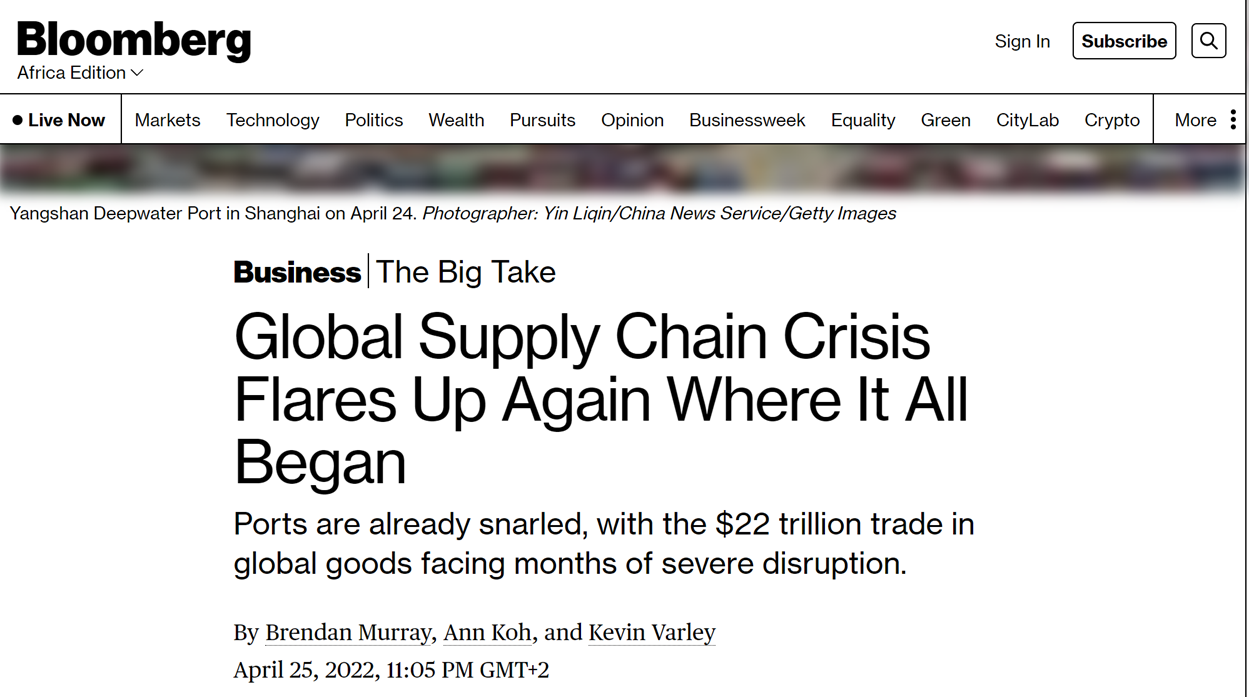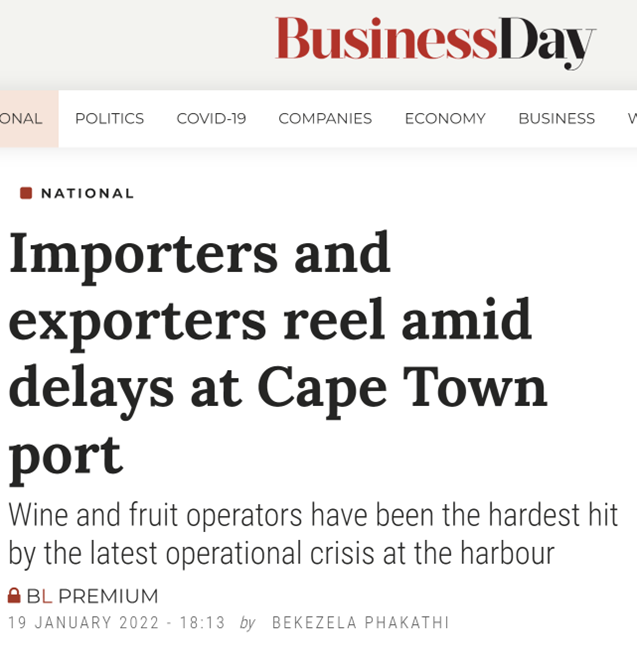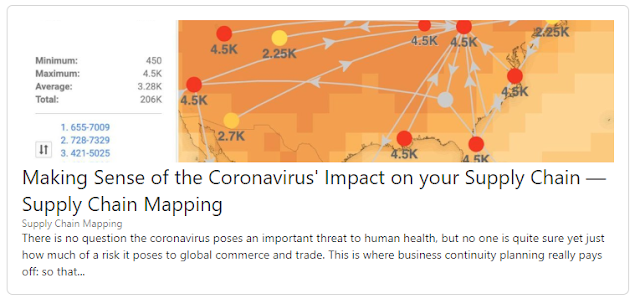SYNOPSIS: Having no visibility, real-time insights, or reliable data on business operations or the current status of your supply chains is conceptually not too far removed from driving blind. This article briefly explains some use cases and advantages of operational and supply chain visibility platforms and systems.
ESTIMATED READING TIME: 5min
First posted on LinkedIn - read the ORIGINAL POST here
Updated: 24 Jan 2025
6. For rather obvious reasons, then, it comes as no surprise that research by the authoritative market intelligence and investment advisory firm, CBInsights, emphasised the importance of prioritising supply chain and operational visibility platforms as a focus area for retailers. What’s good for the goose …er retailer, is probably worth seriously thinking about for other players across different value chains and different industries, too.
So, if given a choice, you would not drive blindfolded, right? Where do you see Visibility adding the most benefit to your business?
Need more information? Want to start a pilot project? Please contact us

#IOT #retail #supplychain #riskmanagement
Photo-credits:
All media belongs to their respective owners.
Shark photo Jacob Owens + Warehouse Photo by Bernd Dittrich found on Unsplash
You wouldn’t drive your car blindfolded, would you?
Driving blind is a dangerous and potentially life-threatening practice, perhaps best left to trained movie stunt professionals on movie lots. The rest of us, social influencers included (even those with very deep pockets and extensive liability cover), should best stay far away.
While the image in the title has been Photoshopped somewhat, a YouTube video appeared in which a popular YouTuber filmed himself driving blindfolded. The video sparked a public outcry and negative news coverage, as one could expect. This resulted in the video initially being age-restricted and demonetised, and then subsequently removed by YouTube.
The risks caused by driving blind are rather obvious and easy for all to see - apart from the aforementioned YouTuber, and include at least the following:
- Inability to see where you are going.
- Inability to see how the situation around your vehicle and inside the vehicle is changing in real-time.
- Inability to effectively make informed decisions in real-time or timeously execute corrective action to best adjust to the developing risks and changing situations around you.
- You are very likely to cause or end up in an accident, incurring costs, losses and liability claims, including but not limited to loss of life.
The same goes for managing and coordinating the various activities inside a business: in today’s equally volatile and fragile economic climate, no accountant worth his salt will manage the finances of a business blind-folded either – meaning without knowing with a reasonable degree of certainty how much the expenses are, who needs to be paid or when the payments are due, or how many invoices are outstanding and how much is owed by each debtor.
If visibility is such an obvious requirement for driving and finances, why are there parts of business operations that are still “operating in the dark”, figuratively speaking?
Have a look at almost any media outlet or newspaper and one will see headings describing losses, damages, delays, bottlenecks, shortages, and other supply chain challenges brought on by a mix of internal and external factors as well as foreseeable and unforeseeable risk events. Many existing but previously manageable challenges were upgraded and further exacerbated by the great Supply Chain crisis of 2021-2022. This in turn was brought on by (some would say ill-considered) pandemic emergency measures, which caused systemic shocks, stock outages, and shortages, shutdowns of suppliers (both temporary as well as permanent in nature); significant supply chain delays; economic hardship; and increased volatility around the world. In the process, some entirely new problems were created. The only constant is change.
In no specific order, below please find a short list of 12 examples of current supply chain and operational challenges, many of which may or could affect business operations in the Southern African (or international) market:
Please scroll through this list. While this is by no means intended to be an exhaustive or comprehensive list, it does highlight the wide range of challenges that local businesses confront from time to time, some of which occur daily, including:
- Supply disruption due to lockdowns
- Cargo and freight handling delays, accidents and incidents
- Wastage, damages and shrinkage to perishable foodstuffs, fresh fruit and veggies
- Political unrest, riots and looting targeting the supply chain, transporters, and warehouses
- Import and export delays, shipping delays, border congestion and delays
- Counterfeit products, supply chain control gaps, shortages and stock-outages
- Natural disasters, flooding, transport infrastructure (ports, docks and roads inaccessible), unavailability of services due electrical outages, water bursting, etc
Many of these problems are caused by external factors beyond the control of the average company; they are not isolated occurrences; they are not limited to specific suppliers or carriers; they are not necessarily industry-specific; and they can and do affect the entire Southern African economy, including international supply chain networks. And these issues have disastrous effects on operational efficiency and bottom-line profits. Research by McKinsey indicates that “supply-chain disruptions cost the average organization 45 percent of one year’s profits over the course of a decade.”. For South African businesses, the cost of e.g. importing goods has increased significantly, with a 400–500% cost increase for freighting a 12-meter container by sea from China to South Africa, even for large organisations with bargaining power. On some international trade routes, shipping costs have increased much more. Risk has increased significantly. Many of these costs are passed on to the consumer, who is now faced with rapidly increasing living expenses, rising inflation, and considerably less discretionary spending power, which, in turn, reverberates throughout the economy.
It is therefore advisable to use every tool in your arsenal to pro-actively respond to the changing situation around you. Because every load counts.
So what is Visibility?
Visibility platforms (software + tracking devices) compile and analyse real-time data across the shipping journey to provide end-to-end shipment visibility across different industry applications.
This means a commercial customer has the ability to track-and-trace assets or inventory live and in real-time, e.g. from the point where the item/shipment leaves the farmer's, manufacturer’s, supplier’s, or service provider’s warehouse/distribution centre up to the point where it arrives at the destination, allowing you to keep track of the current location, condition, and status of these items throughout the journey.
- Visibility platforms are frequently used for supply chain visibility but can have other related applications, e.g. large and complex business operations. It is important to understand that the visibility requirements can vary somewhat between e.g. a logistics business/farmer/manufacturer/distributor/retailer/importer/exporter, which could be very different from the visibility requirements of a bank or a pension fund.
- Different technologies are on offer and the platform can obtain data via API, directly from telematics or other types of tracking IOT devices.
6 Reasons why your business needs visibility
Consider how your company could profit from having Real-Time Visibility into your operations and access to a Single Version of the Truth:
- Transparency - having real-time end-to-end IOT visibility on where your operational assets/inventory/shipments are, with hyper-accurate location information, despite using numerous 3rd party logistics providers or channels, such as warehouses, handlers, or distributors in multiple locations
- Tracking important performance data - Key indicators such as transit time, stops and halt periods, loading times, or whether unauthorised pauses or unexpected delays occurred are all available on the fly. This provides you with knowledge, allowing you to forecast if your operational assets, inventory, or freight will arrive on time, ahead of plan, or behind schedule. And allows you to keep track of supplier performance.
- Auditability - Having an audit trail to prove real-time conditions of fragile or high-value inventory / perishable shipments. Knowing if the cargo was handled in accordance with SLA and or regulatory compliance requirements for the duration of the trip.
- Real-time condition reporting - Knowing the condition of your perishable/fragile shipments in real-time, and being able to pinpoint and allocate accountability for damage if and when it occurs.
- Real-time actionable insights
- Make fact-based decisions to respond to and manage exceptions,
- Reduce costs and minimise damage to fragile and perishable goods, shrinkage and or losses of high-value goods,
- Identify operational bottlenecks,
- Make data-driven decisions to develop business cases, mitigate risks or loss prevention strategies,
- Improve the quality of forecasting and inventory management,
- Maximise operational efficiency,
- Increase customer satisfaction,
- Improve profitability,
- Withstand and defend against disruption.
The aforementioned cover some of the advantages that Visibility platforms have to offer – including aggregated, real-time data about the movement of freight along the shipping journey, providing end-to-end shipment visibility.
6. For rather obvious reasons, then, it comes as no surprise that research by the authoritative market intelligence and investment advisory firm, CBInsights, emphasised the importance of prioritising supply chain and operational visibility platforms as a focus area for retailers. What’s good for the goose …er retailer, is probably worth seriously thinking about for other players across different value chains and different industries, too.
So, if given a choice, you would not drive blindfolded, right? Where do you see Visibility adding the most benefit to your business?
Need more information? Want to start a pilot project? Please contact us

If you have found this article useful or thought-provoking, please share it with others in your company or industry.
Photo-credits:
All media belongs to their respective owners.
Shark photo Jacob Owens + Warehouse Photo by Bernd Dittrich found on Unsplash

































